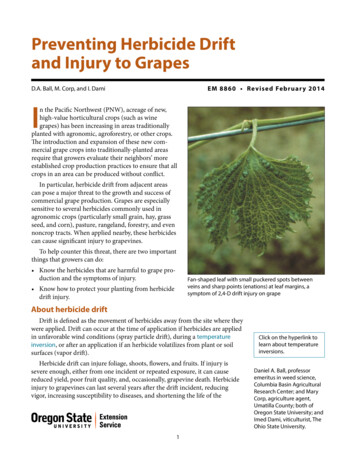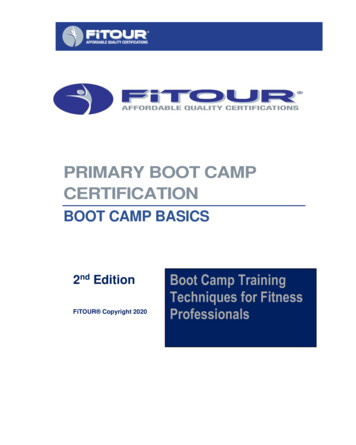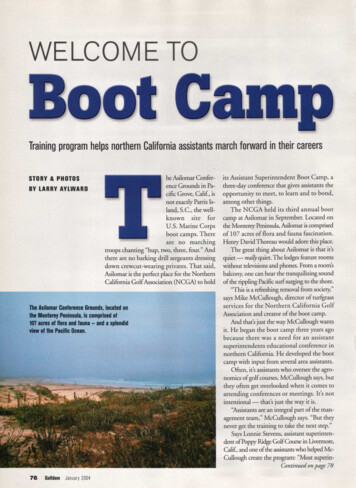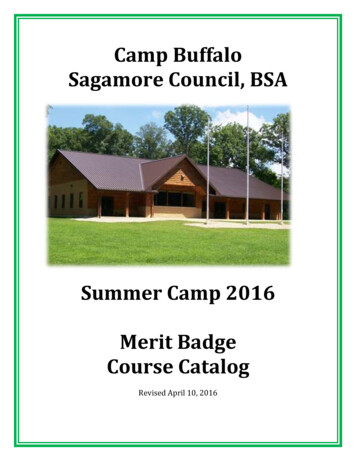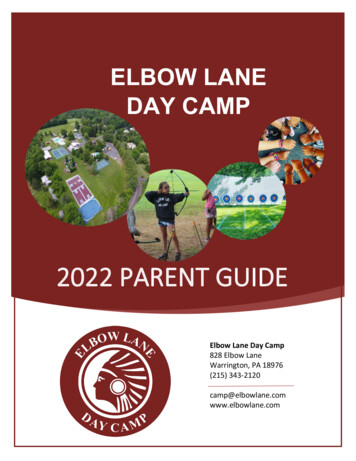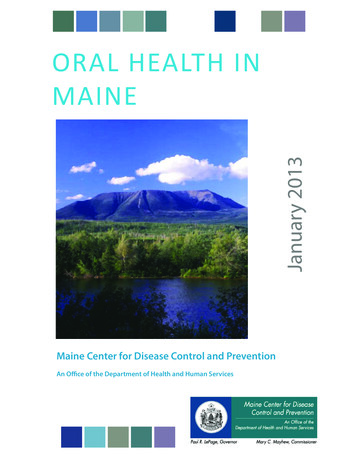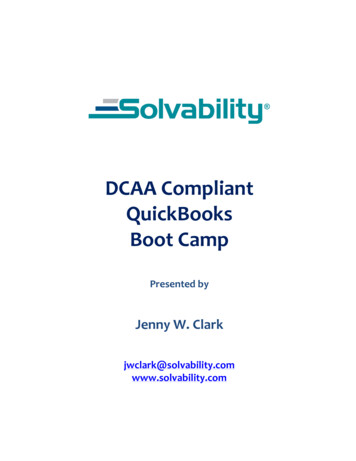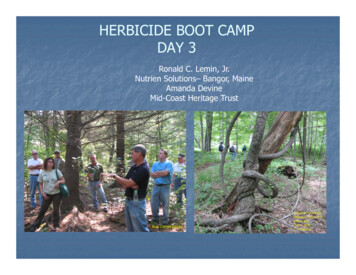
Transcription
HERBICIDE BOOT CAMPDAY 3Ronald C. Lemin, Jr.Nutrien Solutions– Bangor, MaineAmanda DevineMid-Coast Heritage TrustRon Lemin photo
Outline Herbicides Mode of Action Selective vs non-selective Residual vs non-residual Pre-emergent vs Post-emergentMost common herbicide choices for invasive plant controlApplication techniquesLicensing, wetlands, permits, variances, etc.Weather impacts on herbicide selection
IPM Control Strategies Cultural Manual or Mechanical Biological Genetic Chemical/herbicides
CHEMICAL OR HERBICIDECONTROL
For an herbicide to be an effective, itmust:1.Contact the plant surface2.Remain on the plant surface long enough tobe absorbed3.Reach a cellular site and disrupt a lifesupporting process or structure4.Degrade into non-toxic metabolites
Herbicide Modes of Action Selective or non-selective Residual or non-residual Foliar absorbed Root absorbed Or both Contact or systemic
Application Methods Ground – Skidder, Tractor, ATVBackpack Foliar - Mist blower,Manual pumpBackpack - Basal BarkStump TreatmentsTree or Plant Injection
Individual Plant Treatment for Woody Plant ControlMonth of ApplicationApplicationJAN FEB MAR APR MAY JUN JUL AUG SEP OCT NOV DECMethodFoliarCutSurfaceLowVolumeBasalafter full leaf‐out in thespring through summer until10% leaf colorationavoid application during spring sap flow and when itis cold enough for spray mixture to freezeyear ‘round except on wet stems 8
Herbicide Effectiveness Herbicides are most effective on a healthygrowing plant.Damage, drought, pruning, browsing canall lead to poor efficacy.When possible, use foliar or basal barkapplications to control plants (they takeadvantage of the entire functioning plant).
Invasive Plant Control Early Detection Rapid ResponseFrom an IPM standpoint less herbicide is used inearly detection treatments .Heavy infestations require more active ingredientand multiple “broadcast” herbicide treatments.Then we may still only be suppressing or reducingtheir spread.Treatments become non-selective and we lose ordamage the native plants in the herbicideapplication.Promote native plant communities (Cultural Controlstrategy of IPM) to fight the spread of invasives.Selective herbicides or spot treatments to protectnative plants.Herbicides are not the “silver bullet” remedy
COMMON HERBICIDESHerbicidePrimary mode of actionChemical nameProduct nameGlyphosateRodeoRoundupImazapyrMode of entryTypeMechanismFoliageSystemicAmino acid synthesisArsenal,StalkerFoliage & soilSystemicAmino acid synthesisSulfometuronOustFoliage & soilSystemicAmino acid synthesisTriclopyrGarlon 4,Garlon 3aFoliageSystemicGrowth regulatorFosamineKreniteFoliar-ContactContactBud Inhibitor2, 4-DWeedone,EsteronFoliage & soilSystemicGrowth regulatorMetsulfuronEscortFoliage & soilSystemicAmino acid synthesisAminopyralidMilestoneFoliage & soilSystemicGrowth regulatorPlateauFoliage & SoilSystemicImazapicAmino acid synthesis
Growth Regulators VersusAmino Acid Inhibitors Growth regulators work very well early in the growingseason when plants are actively growing, and celldivision is occurring. Growth regulators are also selective. Garlon or triclopyr, 2,4-D.They control broadleaf plants but not monocots (grassesand sedges).Amino acid inhibitors work well later in the year asplants begin to store sugars in the roots. Glyphosate and imazapyr
Residual or Pre-emergent An herbicide needs to have soil residualcharacteristics to work as a pre-emergent or longterm to control germination and future sprouting ofinvasive plants.An applicator needs to understand what types of“other” plants that herbicide can control beforeusing a residual or pre-emergent product.Residual can be good, but also bad, if we want tobe selective in our approach and maintain nativeplants to occupy the site (IPM cultural).
Common Herbicides Usedfor Invasive PlantManagement RODEO, ROUNDUP (Glyphosate)GARLON 4 , GARLON 3A, VASTLAN (Triclopyr)PATHFINDER II (Triclopyr and basal oil)ARSENAL, POLARIS(Imazapyr)
RODEO-ROUNDUP Glyphosate, 40 or 54% active per gallonGlyphosate is a Non-selective herbicideRodeo is aquatically labeledAmino acid inhibitor, results in the depletion of 3essential amino acids in the plantGlyphosate works better later in the season asplants begin to produce sugars to store in theroots.Foliar active onlyLocks up tightly with soil moleculesNo soil residual activity
GARLON 4 Ultra Triclopyr Selective herbicide, no grass control Typical auxin type plant response Ester formulation can result in volatility, or offsitemovement.Absorbed mostly through the leaves, but can be absorbedthrough bark, stem and roots.Creates an EC with oil (20% Garlon 4, 80% Bark oil) forbasal bark and cut stump.Oil carries the triclopyr through the bark into the cambium.Foliar applications work better early in the season beforewoody plants begin to shut down.
GARLON 3A, VASTLAN Triclopyr 3-4 lbs active per gallon Aquatically labeled Amine formulation, no volatility! Need to add the surfactant to the mix forfoliar applications
PATHFINDER II Triclopyr 14% and basal oil 86% mixReady to use product for basal bark and cutstump applicationsBest basal control on stems less than 6” indiameter.Year –round application unless snow preventstreatment to the ground.Triclopyr is transported through the bark withthe bark oil.
IMAZAPYR (Arsenal, Polaris) Amino acid inhibitor like glyphosate.Works on 2 different amino acids than glyphosate.Often used in combination with glyphosateBoth foliar and residual!Meristematic growth inhibitorGreat for use on: Woody and herbaceous plantsCan cause injury and death in oaks and ashthrough root uptake in understory treatments.Can even cause “soil flashing” if applied in basal orcut stump treatments.
Application Basics –(Low Volume Foliar) Spray herbicide directly onto foliage of individual plants.Use spray pressures and techniques that minimize spraydrift.Get good coverage on the growing tips and terminal leader.If you cannot reach the top, it may require cutting andtreating the stump or the following year’s sprouts.Spray front and back sides of the target clump to ensureadequate coverage.Apply the herbicide solution at a volume that wets thecrown but minimizes runoff.
Cut Stump Applications UsingWater Based Herbicides :Garlon 3A, Vastlan,GlyphosateTreat the stump as soon as possible aftercutting. If more than one hour has elapsedsince the time of cutting, you will need to useone of the oil-based products. Treat only theexposed cambium area next to the bark andaround the entire circumference of the tree.Rates: 50/50 herbicide and water.
Cut Stump Techniques for Oilbased Herbicides :Garlon 4 and oil (20%/80%), PathfinderII (RTU)Anytime after cutting, including winter months.Do not make applications when snow or waterprevent spraying to ground level. Treat theexposed cambium area and the root collar(exposed bark on the side of the stump) downto the soil line. Be sure to treat the entirecircumference of the tree. To ensure effectivecontrol on large trees, also treat any exposedroots that surround the stump.
Cut Stump Treatment withRodeo or Garlon 3ACut Stump Treatment withGarlon 4 and oil
Basal Bark Garlon 4 Ultra and Oil (20%/80%) or PathfinderII (RTU)Individual plant treatment.Great option for smooth barked plants likeAutumn oliveAnother option for large bittersweet vines. Noneed to cut the vine then treat the surface.Be careful of adjacent desirable plant stems orroots!
Some Unique ControlStrategies With Herbicides
Selectivity with a non-selectiveherbicidein combination with glyphosate
Timing Invasive plants often leaf out earlier thannative plantsThey also can hold on to their leaveslonger.This trait can allow for foliar applicationsof non-selective herbicides to protectnative plants.
April 13th low volume foliar w/ Garlon 3A4 weeks after treatment
Glossy Buckthorn Treated with 5% Accord XRT 2nd week of October 20097 MAT
Common Buckthorn Treated Nov 14, 2010, and 8 Months After Treatment
Honeysuckle Control Foliar control with triclopyr alone is not aseffective as glyphosate in the late summerto fall.Glyphosate on honeysuckle, even whenthe leaves begin to turn yellow, is veryeffective.If triclopyr is used, add another product tothe mix (Escort, imazapyr, Milestone).
Barberry Usually easy to control with Glyphosate orGarlon.Early bud break species, use Garlon tocontrol in spring.Glyphosate later in season to fall.
Knotweed Control If possible, a combination of glyphosate,imazapyr and Escort will work well.8-10%, ¼%, 4 oz per 100 gals respectivelyNeed to be careful on root zone applicationswith imazapyrI have used the Milestone or triclopyr in earlyseason applications and followed up withglyphosate later.
APPLICATION AROUND WETLANDS Can apply up to edge of wetlands as long as it is nota broadcast application.Cut stump or basal stem treatments are “not”broadcast treatments.Must stay 25 feet away from water for broadcastapplication.Key factor is whether or not pesticide will be directlyapplied to water, and what the label allows.Would advise against application to areas that oneknows will result in getting pesticides in the water.Discuss these situations, especially with the Board ofPesticides Control before making applications.
APPLICATION AROUND WETLANDS Many invasive plants Loosestrife, Phragmites,Knotweed, and Glossy Buckthorn can grow in andaround wetlands.The herbicide label specifies whether one can applyin a wetland or how close the application can bemade to a wetland.State regulations may be stricter than a federal label.To apply to a wetland area, an applicator needs to becertified in aquatics.
APPLICATION AROUND WETLANDS If broadcast herbicide applications are requiredwithin 25 feet of a wetland, consult the Maine Boardof Pesticides Control.A variance may be required prior to application.An application to a wetland, or an area with standingwater most likely will require a permit from the MaineDEP.Both organizations are very good to work with“proactively”.Make sure your site plan indicates the need todetermine whether a permit and applicator with theappropriate licensing may is required before anyapplications are made.
Do you need a commercial orprivate applicator license?You need a commerciallicense when makingapplications: on property you oryour employer do notown or leasefor compensation orunder contracton property open touse by the publicas a governmentemployeeYou need a private licensewhen making applications: on property you or youremployer own or leaseto produce an agriculturalcommodity as defined in Title22 Section 1471-C(1)when making aerialapplications to an agriculturalcommodity on property you oryour employer own or leaseSlide borrowed from Megan Patterson,Maine BPC
Applicator certification/licensingrequirementsPrivate licensesCommercial licenses Exams Minimum passing score 9 credit hours form master6 credit hours for operatorSpray contracting firm?Exams 80License fee Core, Forestry, AerialMinimum passing score 105 for a three-year licenseRecertification requirements 80*Licensing fee Core, Forestry, Aerial,Regulations, and Oral Master’s 15 for a three-yearlicenseRecertificationrequirements 6 credit hours everythree yearsSlide borrowed from Megan Patterson,Maine BPC
Herbicide Application ByUnlicensed Individuals Landowners can apply “general use” pesticideson their own property.Unless the property is open to the public orgovernment property.General Use means Not Restricted Use (Federalor State).State of Maine restricts aquatically labeledproducts.Glyphosate (non-aquatic), Garlon 4 Ultra,Pathfinder II are General Use
Aquatic Use Labels for CommonBrush Control Herbicides Rodeo– Has had the aquatic use labeling forseveral years. Glyphosate products with surfactantare not aquatic labeled.Arsenal Applicator Concentrate and Polaris(Imazapyr) – Several of the 4 lb and 2 lb activeimazapyrs have aquatic uses on the label now.Triclopyr – Corteva’s Garlon 3A and Vastlan bothhave aquatic uses.All are Restricted Use under Maine’s PesticideRegulations.
Weather Effects on HerbicideApplicationsWeather Precipitation Wind(speed & direction) Temperature Humidity
Rain or Heavy Dew Herbicides need to be applied to surfaces to be absorbed into plant orwatered into the soil.Applications before heavy rains can prevent this from occurring. Wasted application ( ) Pesticide washes off to another area? May have to retreat.Spraying in heavy dew. If the leaf is saturated with heavy dew, the added droplet andsurfactant can cause the leaf to expel the water and in effect lose theactive ingredient. One should know how much dew is present prior to application tominimize active ingredient loss.
Precipitation – Rainfastness Rainfastness is a common term we use for pesticideapplications.Applicators should select pesticides with rainfastness traitsnecessary for the weather projections at the time ofapplication.For instance, Triclopyr can pass through the leaf cuticleusually within 30 minutes, while Glyphosate takes almost 2hours or more to fully penetrate the leaf.Adjuvants called stickers can help “stick” the active ingredientto the surface once the droplet has dried to prevent wash offafter application.Selection of a pesticide with good rainfastness characteristicsis an important factor when rain is predicted.
Wind Wind has both SPEED and DIRECTION which can affectyour pesticide application.If you are applying a pesticide in the form of a spraydroplet, wind speed and direction are “extremely”important factors one should be aware of prior to pullingthe trigger!Wind can carry your spray droplet away from yourintended target and deposit it offsite.This event is defined as “Drift”
Spray DriftSpray drift occurs when pesticides move onto nontargeted areas during application. This can causedamage to desirable vegetation, and lead tounwanted environmental, financial, or publicrelation consequences.
Temperature and Humidity Temperature and Humidity can affect the evaporation ofyour spray droplets.If evaporation happens before it reaches your intendedtarget You can lose efficacy It may result in an off-site movement of the activeingredient as a vapor particle. Volatility!Once temperatures exceed 85 degrees and humidity is low(below 50), evaporation of small droplets can be quick andtroublesome.
Temperature InversionsDuring a temperature inversion: A layer of warmer air may develop above a cooler layerThis can happen at any altitude and can be a thick or thinlayer.Temperature inversions can hold spray particles aloft forseveral minutes to hours, allowing for long distancemovement away from the intended targetUsually, inversion conditions occur late evening and into themorning when the winds are calm
Temperature Inversions Decrease the dispersion of droplets that are too small to quicklysettle out.Result in a higher air concentration of these small droplets.Increase the potential for off-target effects.Increase the distance at which off-target effects can beobserved.Increase the size of the area affected.Cause the direction of any drift to be unpredictableThe State of Maine regulations specifically state thatapplications are made when winds exceed 2 mph.The purpose of this regulation is to eliminate the possibility ofapplying during an inversion
Summary Monitor the uncontrollable factors (rain, wind,temperature, etc)Use of proper equipment and chemistrySelect the appropriate pesticide formulationLarger droplets are goodMinimize nozzle pressureShorten the distance from nozzle to targetUse drift control agents and buffers if necessaryDetermine any sensitive areas prior to treatmentIf weather conditions do not favor your equipment,pesticide formulation, and site, do not make theapplication!Move to a more favorable location or wait for anotherday.
Questions?
Invasive Plant Control Early Detection Rapid Response From an IPM standpoint less herbicide is used in early detection treatments . Heavy infestations require more active ingredient and multiple "broadcast" herbicide treatments. Then we may still only besuppressing or reducing their spread. Treatments become non-selective and we lose or
